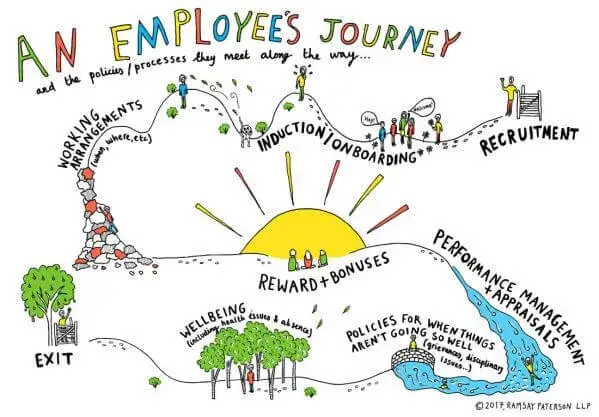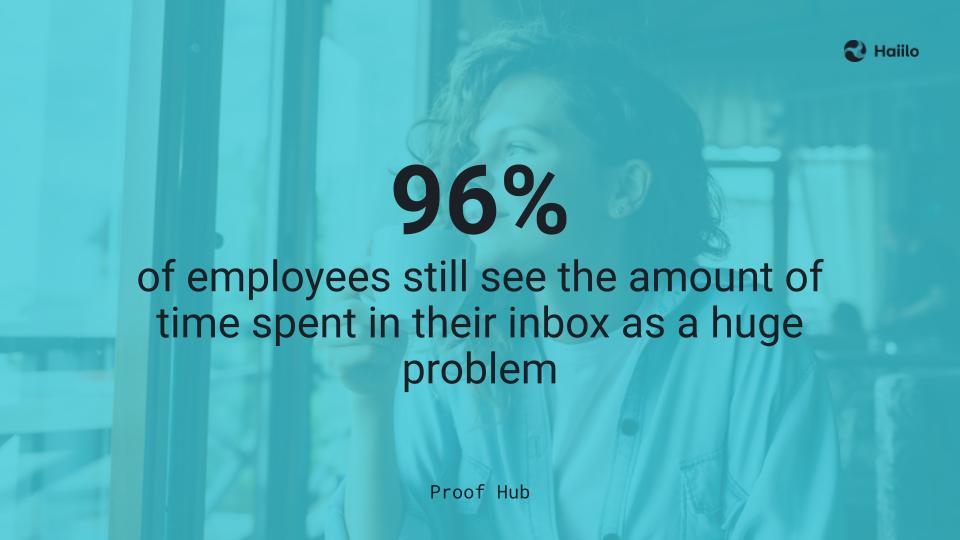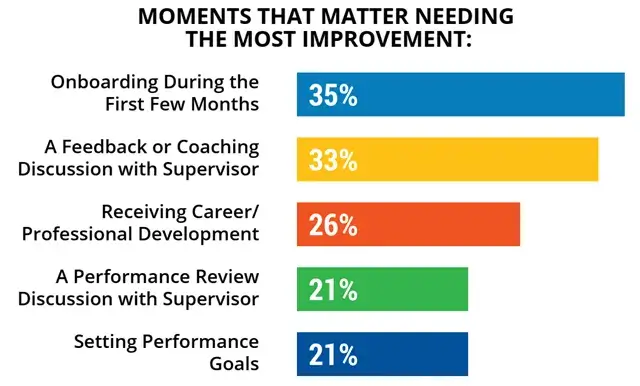Mapping employee journeys can help organizations better understand the different stages employees go through during their employment lifecycle. Understanding these stages enables employers to boost employee satisfaction and provide memorable experiences throughout their employment.
In this blog, we will define the employee journey, introduce the components of every employee journey, and explain how to do employee journey mapping.
What is an Employee Journey?
An employee journey is all the events, touchpoints, milestones, and activities employees take and go through during their employment in an organization.
Some human resources professionals like to use the term “moments that matter” as a synonym for employee journey. Why? Because the main goal of identifying employee journeys is understanding what are the most important moments for employees during their employment. Journeys help companies understand the components that have a positive impact on employee motivation and engagement in the workplace.
Employee journey begins as soon as a person enters the organization and starts interacting with the peers and finishes when the person leaves the organization.
It is important to understand the difference between the candidate and employee journey. While the candidate journey consists of touchpoints that happen before a person enters the organization (recruitment and selection), the employee journey usually starts with onboarding.
What is Employee Journey Mapping?
Employee journey mapping is a process that defines the various touchpoints and experiences an employee goes through from their pre-hiring stage through to their employment life cycle within an organization. It includes applying for the role, interviews, onboarding, managing performance reviews, and offboarding. These improvements can help increase employee engagement, retention, motivation, and performance over the long run.
Defining various employee touchpoints and creating journey maps are even more important now when hybrid work is growing in its popularity.
Employee Journey: 8 Essential Components
Depending on the organization, employee journeys can have a different number of components. However, there are certain components every employee’s journey mapping consists of.

1. Onboarding
Every employee journey starts with onboarding. Including onboarding in employee journey mapping is important because onboarding experience can significantly impact employee engagement, productivity, and retention.
According to Glassdoor, organizations with a strong onboarding process improve new hire retention by 82% and productivity by over 70%.
2. Compensation and benefits
Compensation and benefits play one of the most important parts of every employee’s journey. Moreover, salary is still the number one factor impacting employees’ work satisfaction. Here, it is crucial to understand the importance of a fair compensation structure within the organization and provide competitive compensation packages aligned with employees’ expectations.
Sometimes, additional benefits can be even more important than the base pay. For example, some employees would accept a pay cut in return for flexible working hours, good healthcare benefits, and other employee well-being programs
According to Deloitte, one in three professionals say work flexibility would increase their job satisfaction and morale, and almost 30% say it would increase their overall productivity or efficiency at work.

3. Growth and development
Continuous learning and development are often in the top three priorities for employees who want to grow their careers. This is why many organizations today have structured career planning plans and strategies.
According to research, 74% of employees do not believe they are reaching their full potential at work, and 52% of Millennial and Gen Z workers believe that opportunities for advancement a company an attractive employer.
Being aware of this fact and creating career growth plans can, therefore, help organizations to both attract and retain top talent in their organizations.
4. Performance management
Employee performance management is one of the most important components of every employee’s journey. Organizations need to reconsider traditional performance management systems where managers yearly or quarterly evaluate their people.
According to research, 90% of employees think performance reviews are painful and inefficient, and 51% of them think they are inaccurate.

Rather than waiting for quarterly or yearly reviews, employees should be able to give and receive on-the-spot feedback. This approach enables employees to stay on track with their goals, KPIs, and OKRs.
5. Internal communications and team collaboration
Remote work and distributed workplaces have had a significant impact on the importance of honest, transparent, and frequent internal communications. This pandemic is the most stressful time of many people’s lives, and they expect full transparency from their employers.
This is the reason why many organizations are now investing in implementing proper employee communications strategies. They are also digitalizing their workplaces so that employees can easily collaborate with each other using various team collaboration solutions.
📹 Also watch our session: Engaging a Remote Workforce.
6. Personal events
Many organizations tend to forget about employees’ personal events when identifying employee journey components. This is a big mistake as exactly these events make some of the most important moments in employees’ lives.
For example, personal events such as maternity and paternity leave should never be excluded from career journeys. Employers should put effort into making these moments more memorable and enjoyable to their people.
Not only that this approach boosts employee morale, but it also helps organizations build a stronger employer brand.
7. Digital Employee Experience
When building and evaluating employee journeys, many employers still neglect the importance of digital employee experience. Digital employee experience is the experience employees have with various technologies used in an organization.
Because of the emergence of remote and hybrid work, many employees today depend on digital solutions their company provides. Even though there is plenty of research that proves the benefits of digital solutions, many organizations are yet to digitalize their workplaces. As a consequence, 96% of employees still see the amount of time spent in their inbox as a huge problem.

This is the reason why organizations are now turning to modern, more sophisticated, and mobile-friendly employee engagement apps, internal communications platforms, and other workplace technologies.
8. Exit interviews
Exit is an employee journey component no less important than previously mentioned pillars. Even though this is the moment when employees leave their organizations, it is important to make this experience positive.
Performing exit interviews is a great way to understand employees and improve your processes based on their feedback.
How to Create an Employee Journey Map?
One way to create an employee journey map is visualize these different stages on a linear map or diagram. This helps employers and HR teams get a clear picture of the journey. Different colors or icons are often used to distinguish stages, which can provide insights into potential pain points, gaps, or areas for improvement.
In the world of customer experience, journey mapping is not a new methodology. Companies have realized years ago that mapping customer experience can enable them to provide a better and more personalized experience to their buyers and, therefore, positively impact business growth and revenue.
One customer journey mapping research report showed that:
- 90% of organizations who used journey mapping found it delivered a positive impact.
- Journey mapping leads to an increase in customer satisfaction.
- Journey mapping leads to an increase in Net Promoter Score (NPS).
- Reduced customer churn.
- Fewer customer complaints.
Because organizations now understand that employee experience directly impacts customer experience, it is not surprising that many organizations are turning to employee journey mapping practices.
Let’s take a look into best practices for mapping employee journeys.
Employee Journey Mapping: 4 Crucial Steps
Mapping employee journeys take time. The most important step in every employee journey mapping process is engaging your own employees in order to better understand their needs and “moments that matter” to them.
These are the 4 must-follow steps for creating employee journey maps:
Step 1: Define employee personas
Mapping employee journeys need to start with defining employee personas. In most organizations, there are multiple employee journeys based on employee profiles. It is important to segment your workforce in order to create personalized journeys with a high impact on employee engagement, satisfaction, and performance.
HR professionals in talent acquisition have been practicing this approach for a while now. Creating candidate personas is crucial for understanding job seekers and attracting the right people to your organization.
Now, it is time to adopt the same approach when creating employee journeys. Understanding various employee needs, preferences, skills, experiences, and career goals is a powerful way to create journeys that will have a positive impact on your employees’ overall experience.
Step 2: Define moments that matter
In the previous section, we introduced the most important components of employee journeys and career paths. These components can also be called “moments that matter”, and these moments can vary among different employee personas.
The best way to identify these moments is to ask employees for their own feedback. In this digital age, regular employee surveys can be the best and quickest way to gather and analyze responses from employees.
According to one research, these are some of the moments employees see as most important.

Step 3: Set measurements for each of the journey components
After defining moments that matter, it is important to define measurement for each of the journey stages. This is the only way to scale the entire process and to keep improving it continuously.
Each of the defined stages should have a set of KPIs or initiatives. Here are some examples of goals you can set:
- Improve employees’ onboarding experience
- Implement a solution that will enable easy and instant top-down and bottom-up feedback
- Create and launch structured learning and development programs
- Implement regular employee surveys to understand the current state of employees’ experiences
Step 4: Measure and keep improving
Measuring employee journey initiatives is important for continuous improvement. Here, asking for regular employee feedback is the best way to understand bottlenecks and opportunities for improvement.
Encouraging employees’ share of voice is the only way to get honest feedback and stay on track with various employee journey projects.
Unfortunately, many employers today still send generic surveys to the entire workplace, and most of them don’t even have a way of reaching their deskless and frontline workers. As a consequence, organizations lack valuable data that can enable them to make smart, data-driven decisions.
If you are looking for a modern and intuitive solution to continuously engage your employees in your employee journey initiatives and to regularly send personalized communications and employee surveys, schedule a Haiilo demo and learn about the power of proper employee communications!









